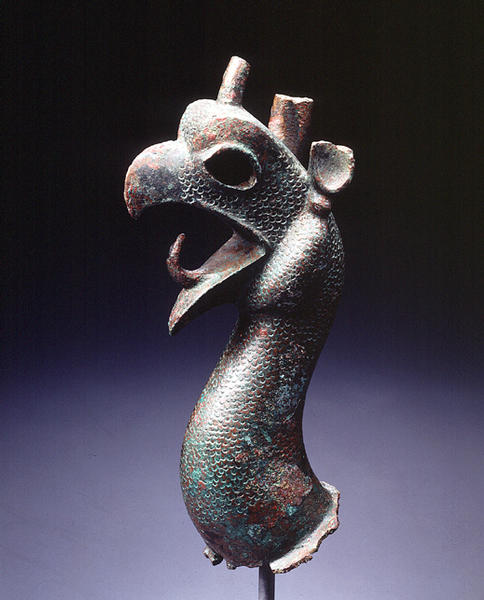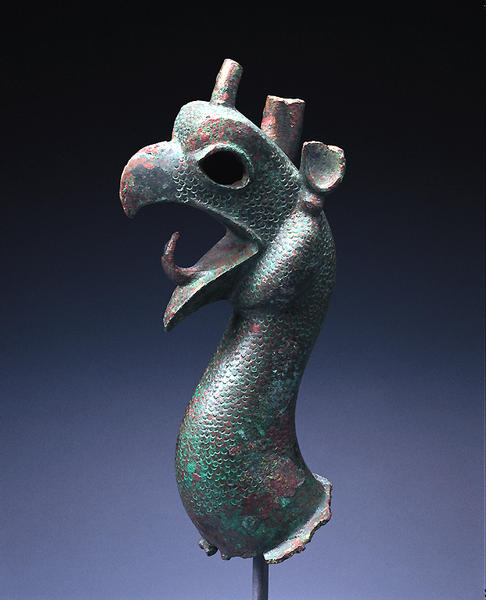Griffin Protome
- Greek, probably from Samos
- 7th century B.C.
- Bronze
- H-21.7
Catalogue Entry
This represents the protome, or forepart, of a demonic griffin, a mythical Near Eastern monster that became extremely popular in Greece during the early Archaic period (about 700-575 B.C.). The griffin has an eagle's head--from which rises a slender stem topped by a knob and two long, thin ears--and a serpentine neck that would be joined to a feline body with wings, but here the beast was truncated to form just the protome, by which name such objects are known. Along with several others like it, this protome was once riveted to the shoulder of a bronze cauldron (wide-mouthed hemispherical basin), which sat on a separately made bronze stand. Made as gifts for the gods, griffin protome cauldrons were deposited in the sanctuary of Zeus at Olympia, the temple of Hera on the island of Samos, and other important Archaic period religious sites. Both the griffin and the cauldron existed independently in the Near East, but it was the Greeks who first combined them.1
Although hollow-cast, this griffin protome has several solid components, including the remains of the ears and stem, and the pointed tongue that curves upward and in to complement the curve of the open beak. The solid eye sockets, surrounded by thick rims, were once inlaid, perhaps with glass paste. On either side of the face is a bulge from which rises a shallow ear with a thick rim. Another rim contours the edge of the upper beak. Rows of overlapping scales made with a crescent-shaped punch cover all but the griffin's extremities.
Griffin protomes have been divided into groups based on style, and this example is closest to the Berlin type of Group VI, which includes protomes found on Samos.2 A later study of Samian protomes isolated a type with similar anatomical features, and a comparable use of long curving lines that end abruptly at sharp angles as a visual means of heightening the beast's alarmed expression.3 Other examples of its type suggest that this griffin protome may have had a conical knob atop its stem, as well as slender, tapering ears.
KM
1. Muscarella 1992, pp. 35-36.
2. Jantzen 1955, pp. 72-77, nos. 108-16.
3. Jantzen 1958, pp. 26-48, figs. 28-52, esp. pp. 39-43, nos. 132b, 135a-b, 108a, 103b-g.
Catalogue Entry(Bac#015)
7th century B.C.
Bronze
H. 21.7 cm
In addition to their commercial ties, the kingdoms of the Hittites, Egypt, and Mesopotamia shared deep intellectual and social interchange in the latter half of the 2nd millennium BC. The peoples of the Mediterranean had since antiquity fluctuated between a nomadic life-style and settled life-style. There was also a tradition of cauldron offerings to temples. Herodotus notes that the Samians (or Ionians) of Samos discovered new trading and commerce areas, and when they reaped large profits from this trade he records that they donated a large bronze cauldron with griffin decorations to the temple of Hera.
This griffin-shaped ornament is shown with one horn topping its head and a wide open vertically symmetrical mouth. Large donkey ear-shaped ears, now with bent tops, would have originally stood straight and vertical. There is a protruding collar-like band beneath these ears. The fringe which would have been used to attach this griffin head to a cauldron remains around the bottom of its neck. The head has a hollow interior and a semi-circular feather pattern has been carved into the cast surface with chisel or graver. The eye sockets are now empty, but originally they would have been inlaid with glass paste. The style of the figure is simple and closely resembles that of the bronze griffin ornament of ca. 7th century BC which has been excavated on Samos. By contrast, the Olympia-form griffins from the Greek mainland of this same period were more decorative and had exaggerated beaks.
Around the beginning of the 1st millennium BC, this type of cauldron was taken from the central metalwork district of western Asia, Urartu to such eastern Mediterranean regions as Greece and Etruria. While the bull was used as the decorative ornaments on these cauldrons in western Asia, the Greeks chose to adorn their cauldrons with griffins. The griffin is known as the protector of gold in Greece, and there was also a sense of the figure as a protection from evil.

